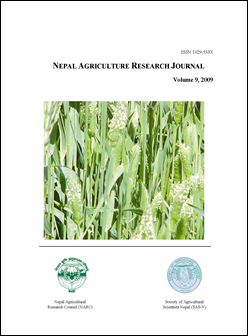Soil Fertility under Improved and Conventional Management Practices in Sanga, Kavrepalanchowk District, Nepal
DOI:
https://doi.org/10.3126/narj.v9i0.11639Keywords:
Improved soil management practice, Organic matter, Soil fertility, UplandAbstract
A study was carried out to compare the fertility of soils under improved soil management practice with that of prevailing conventional practice and to assess the farmers’ perception on the improved practice in the upland farming system. The study was carried out in Nasikasthan Sanga of Kavrepalanchok district of Nepal. Soil samples were collected from fields under improved conventional practice. Samples were taken at 0-15 and 15-30 cm depths and were analyzed for various physico-chemical properties to compare the fertility status of the soils under both the practices. Altogether 68 farmers were interviewed to have information on farming practices and information pertinent to improved soil management practice being adopted by them. Results from soil physico-chemical analysis showed higher fertility of soils under improved practice in terms of more favorable pH level, contents of exchangeable bases, available phosphorus and soil organic matter compared to prevailing conventional soil management practice. Moreover, majority of the farmers believed that soil fertility and physical condition of their upland soils had improved and that the productivity of major upland crops had also increased after the adoption of improved soil management practice. Improved practice could play an important role in the sustainable management of upland soils in the mid hills of Nepal. It is however, desirable to conduct long-term research to further ascertain the effect of the practice on soil fertility of different soil types and land uses.
Nepal Agric. Res. J. Vol. 9, 2009, pp. 27-39
DOI: http://dx.doi.org/10.3126/narj.v9i0.11639
Downloads
Downloads
Published
How to Cite
Issue
Section
License
This license allows reusers to copy and distribute the material in any medium or format in unadapted form only, for noncommercial purposes only, and only so long as attribution is given to the creator.




